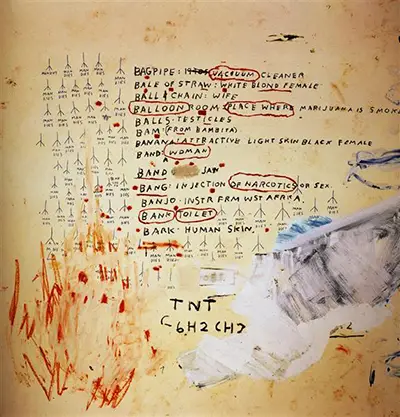This version of the series captures a seemingly random selection of words in a list, including "Bale of Straw", "Bagpipe" and "White Blonde Female". Each entry in the list is accompanied by a number of arrows to the left hand side which roughly resemble the anti-nuclear symbol. Each of those also hold different labels below them. There is then a flurry of paint across the bottom half of the artwork, with red strokes of paint and then a large solid area of white and grey. These parts seem fairly random but it is likely that Basquiat was expressing himself here with a conscious thought, but in a way that we cannot really understand. The background to this piece is left untouched, and would have been the original colour of the blank paper or canvas, prior to the artist starting the design. See also Eroica and Eroica I for further examples of this series.
We do know that the overall series was likely inspired by the death of Andy Warhol and that this event led to a grieving period for Basquiat. His hero had now become entirely mortal and this impacted how Basquiat looked at his own life, in a negative and anxious way. That said, even knowing this does not help much in explaining some of the content within this specific painting, but more so answers questions around the series as a whole, which many still consider to be amongst the most impressive body of work from across his career.
Whilst taking on the theme of death within this series of artworks, Basquiat would draw on all manner of different inspirations and ideas within his career. Some of these were more obvious than others, as his mind was complex and his art somewhat disorganised in appearance. In reality, he planned his compositions well, but did not follow standard practices that most art students would be taught. He respected the old masters but did not wish to follow their technical ways, and wanted to forge his own path that reflected the very different background of his own lifetime. There have been very few to have achieved as much for black art as Basquiat, and his progress has opened the door for hours to achieve a greater prominence for their own careers, with mainstream galleries and museums now being a little fairer in how they go about curating their collections.


